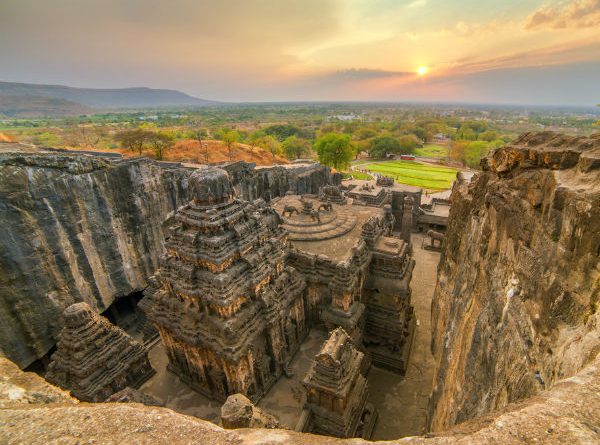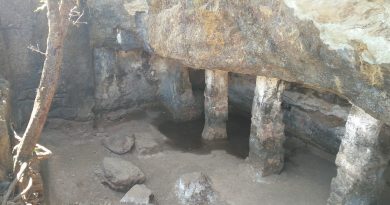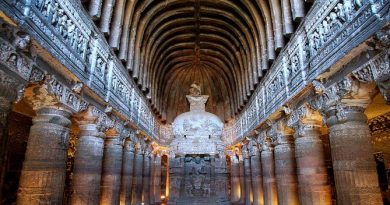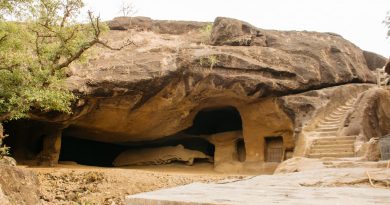Ellora Caves
Ellora also known as Ellooru, is an archaeological site…
Ellora also known as Ellooru, is an archaeological site, 29 km (18 mi) North-West of the city of Aurangabad in the Indian state of Maharashtra built by the Rashtrakuta dynasty(Kannada: ರಾಷ್ಟ್ರಕೂಟ). Well known for its monumental caves, Ellora is a World Heritage Site. Ellora represents the epitome of Indian rock-cut architecture. The 34 “caves” – actually structures excavated out of the vertical face of the Charanandri hills. Buddhist, Hindu and Jain rock-cut temples and viharas and mathas were built between the 5th century and 10th century. The 12 Buddhist (caves 1–12), 17 Hindu (caves 13–29) and 5 Jain (caves 30–34) caves, built in proximity, demonstrate the religious harmony prevalent during this period of Indian history. It is a protected monument under the Archaeological Survey of India.
The Buddhist caves:
These caves were built during the 5th-7th century. It was initially thought that the Buddhist caves were one of the earliest structures, created between the fifth and eighth centuries, with caves 1-5 in the first phase (400-600) and 6-12 in the later phase (mid 7th-mid 8th), but now it is clear to the modern scholars that some of the Hindu caves (27,29,21,28,19,26,20,17 and 14) precede these caves. The earliest Buddhist cave is Cave 6, followed by 5,2,3,5 (right wing), 4,7,8,10 and 9. Caves 11 and 12 were the last. All the Buddhist caves were constructed between 630-700.
These structures consist mostly of viharas or monasteries: large, multi-storeyed buildings carved into the mountain face, including living quarters, sleeping quarters, kitchens, and other rooms. Some of these monastery caves have shrines including carvings of Gautama Buddha, bodhisattvas and saints. In many of these caves, sculptors have endeavoured to give the stone the look of wood.
Most famous of the Buddhist caves is cave 10,(refer map) a chaitya hall (chandrashala) or ‘Vishvakarma cave’, popularly known as the ‘Carpenter’s Cave’. Beyond its multi-storeyed entry is a cathedral-like stupa hall also known as chaitya, whose ceiling has been carved to give the impression of wooden beams. At the heart of this cave is a 15-foot statue of Buddha seated in a preaching pose. Amongst other Buddhist caves, all of the first nine (caves 1–9) are monasteries. The last two caves, Do Tal (cave 11) and Tin Tal (cave 12) have three stories.
The Vishwakarma:
The Vishwakarma (Cave 10) is the only chaitya griha amongst the Buddhist group of caves. It is locally known as Vishwakarma or Sutar ka jhopda “carpenter’s hut”. It follows the pattern of construction of Caves 19 and 26 of Ajanta. On stylistic grounds, the date of construction of this cave is assigned to 700 A.D. The chaitya once had a high screen wall, which is ruined at present. At the front is a rock-cut court, which is entered through a flight of steps. On either side are pillared porticos with chambers in their back walls. These were probably intended to have subsidiary shrines but not completed. The pillared verandah of the chaitya has a small shrine at either end and a single cell in the far end of the back wall. The corridor columns have massive squarish shafts and ghata-pallava (vase and foliage) capitals. The main hall is apsidal on plan and is divided into a central nave and side aisles by 28 octagonal columns with plain bracket capitals. In the apsidal end of the chaitya hall is a stupa on the face of which a colossal 3.30 m high seated Buddha in vyakhyana mudra (teaching posture) is carved. A large Bodhi tree is carved at the back. The hall has a vaulted roof in which ribs have been carved in the rock imitating the wooden ones.
The Hindu caves:
The Hindu caves were constructed between the middle of sixth century to the end of the eighth century. The early caves (caves 17–29) were constructed during the Kalachuri period. The work first commenced in Caves 28, 27 and 19. These were followed by two most impressive caves constructed in the early phase – Caves 29 and 21. Along with these two, work was underway at Caves 20 and 26, and slightly later at Caves 17, 19 and 28.[8] The caves 14, 15 and 16 were constructed during the Rashtrakuta period. The work began in Caves 14 and 15 and culminated in Cave 16. All these structures represent a different style of creative vision and execution skills. Some were of such complexity that they required several generations of planning and co-ordination to complete.
The Kailashnatha:
Cave 16, also known as the Kailasa or the Kailasanatha, is the unrivaled centerpiece of Ellora. This is designed to recall Mount Kailash, the abode of Lord Shiva – looks like a freestanding, multi-storeyed temple complex, but it was carved out of one single rock, and covers an area double the size of Parthenon in Athens. Initially the temple was covered with white plaster thus even more increasing the similarity to snow-covered Mount Kailash.
All the carvings are done in more than one level. A two-storeyed gateway resembling a South Indian Gopura opens to reveal a U-shaped courtyard. The courtyard is edged by columned galleries three storeys high. The galleries are punctuated by huge sculpted panels, and alcoves containing enormous sculptures of a variety of deities. Originally flying bridges of stone connected these galleries to central temple structures, but these have fallen.
The Dashavatara:
The Dashavatara (Cave 15) was begun as a Buddhist monastery. It has an open court with a free-standing monolithic mandapa at the middle and a two-storeyed excavated temple at the rear. The layout of the temple is closely related to caves 11 and 12. Large sculptural panels between the wall columns on the upper floor illustrate a wide range of themes, which include the ten avatars of Vishnu. An inscription of grant of Dantidurga is found on the back wall of the front mandapa. According to Coomaraswamy, the finest relief of this cave is the one depicting the death of Hiranyakashipu, where Vishnu in man-lion (Narasimha) form, emerges from a pillar to lay a fatal hand upon the shoulder of Hiranyakashipu.
The Jain caves:
The five Jain caves at Ellora belong to the ninth and tenth centuries. They all belong to the Digambara sect. Jain caves reveal specific dimensions of Jain philosophy and tradition. They reflect a strict sense of asceticism – they are not relatively large as compared to others, but they present exceptionally detailed art works. The most remarkable Jain shrines are the Chhota Kailash (cave 30), the Indra Sabha (cave 32) and the Jagannath Sabha (cave 33). Cave 31 is an unfinished four-pillared hall and a shrine. Cave 34 is a small cave, which can be approached through an opening on the left side of Cave 33. Amongst other devotional carvings, a place called samvatsarana can be found in Elora caves. Samvatsarana is of special interest to Jains, as it is a hall where the tirthankara preaches after attaining omniscience.
How to reach:
By plane:
Aurangabad is the nearest airport, and there are daily flights from Delhi and Mumbai.
The nearest airport (which is a domestic airport) from these caves is situated in Aurangabad (15 km) and can be reached directly from Delhi, Mumbai, Jaipur and Udaipur.
By train:
Aurangabad is the nearest railway station, and there are regular trains from Mumbai, Hyderabad, Delhi, Amritsar etc. There is an overnight train from Mumbai.
How to Reach Ajanta by Air: Aurangabad, which is about 99 km from Ajanta and 30 km from Ellora, can be reached directly from Delhi, Mumbai, Jaipur and Udaipur airports.
How to Reach Ajanta by Rail: Jalgaon (59 km from Ajanta) is the nearest station where you should alight while coming from Delhi or Mumbai. Two trains Tapovan Express and Devgiri Express depart daily from Mumbai to Aurangabad.
How to Reach Ajanta by Road: Ajanta Caves are connected to a network of excellent roadways with Mumbai, Pune, Ahmednagar, Jalgaon, Shirdi, Nasik, Dhule, Ahmedabad, Hyderabad, Indore, Bijapur, and Aurangabad.
By bus:
Aurangabad is the nearest location for inter-state buses.
Aurangabad to Ellora is around 30km. One can reserve Auto which will charge around Rs 350-400. Or else take Govt Buses from Central bus stop (Aurangabad).
Jalgaon (59 km from Ajanta) is the nearest station where you should alight while coming from Delhi or Mumbai.




